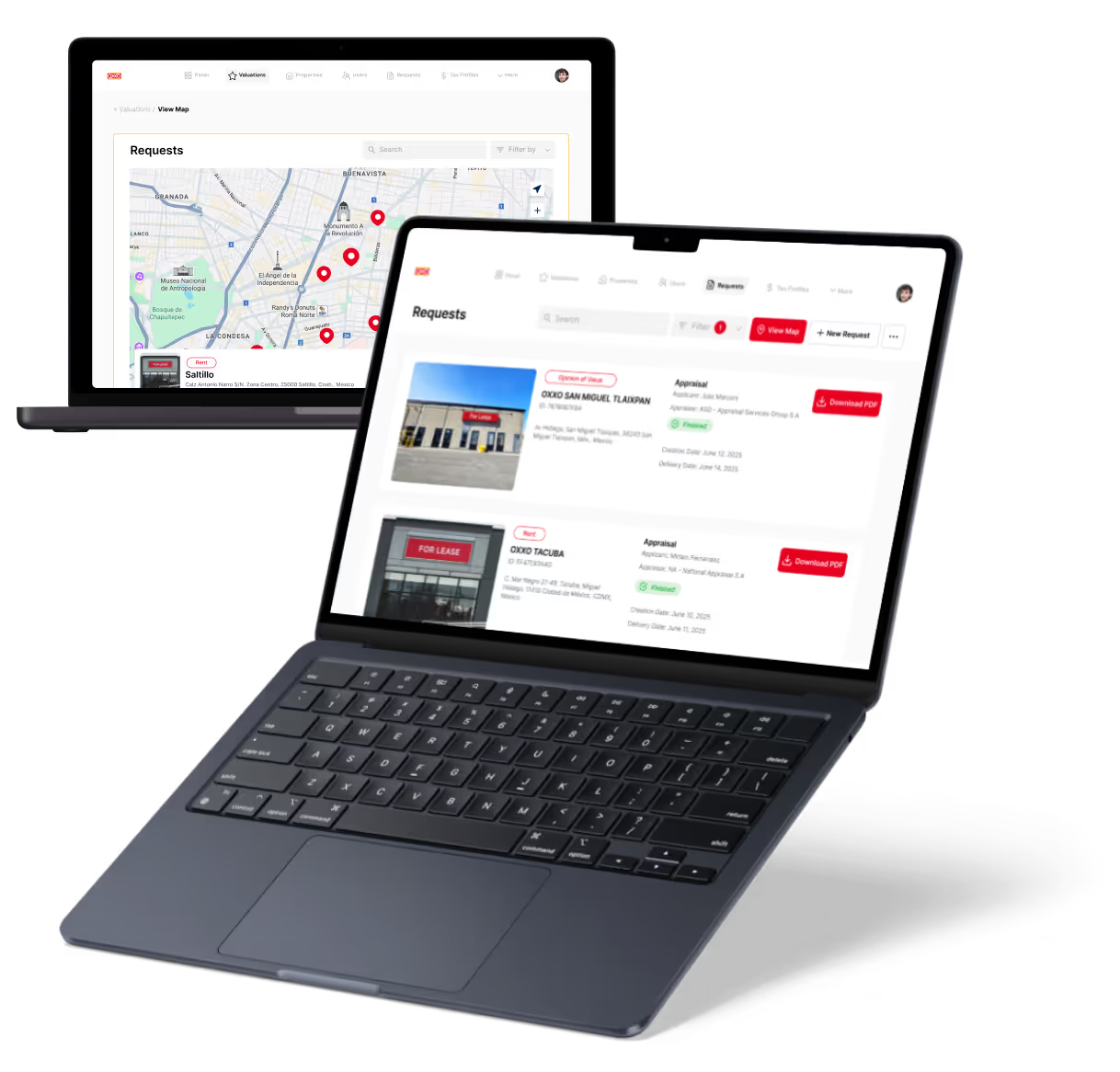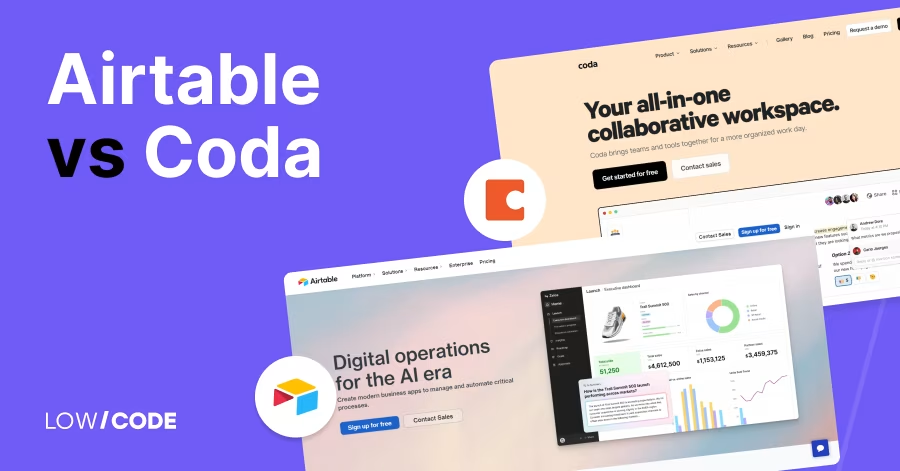Bubble vs Appsheet | 10 Factors to Decide the Best One
16 min
read
Compare Bubble vs AppSheet for building web or mobile apps. Learn which no-code tool fits your app goals, design needs, and workflow logic in 2025

Bubble is now recognized for its visual ability to create complete web and mobile apps, offering control over logic, databases, design, and publishing.
AppSheet, owned by Google, specializes in quickly turning spreadsheets into mobile apps, with built-in offline access and automated workflows. Bubble offers creative freedom, while AppSheet provides speed and simplicity.
Whether you're a startup founder building SaaS or a team automating field operations, this guide explains each tool in terms of design, deployment, performance, integrations, and use cases, helping you decide which one best suits your project.
Quick Comparison Table - Bubble vs Appsheet
1. What’s the core difference between Bubble vs Appsheet?
The core difference between Bubble and AppSheet lies in how they build apps and who they’re made for.
Bubble is a visual no-code platform designed to create full-featured web applications. It offers complete control over design, database, and logic—all in one place. It’s great for SaaS, marketplaces, and internal tools.
AppSheet, on the other hand, is focused on building mobile and tablet-friendly apps from spreadsheets like Google Sheets or Excel. It’s best for field data collection, inventory tracking, and business workflows. You don’t need to design layouts—it auto-generates the UI.
Choose Bubble if you need a web-first app with custom logic, user roles, and full design control. Go with AppSheet if your goal is a mobile app connected to existing data, especially for offline work or team operations without needing to design every screen manually.
2. Web vs mobile experience
Let’s begin by comparing how both platforms handle mobile and web apps.
Does Bubble work for mobile and desktop users?
Yes. Bubble apps are built for the web, but now they also support native mobile apps using the new Bubble Native Editor. You can create responsive layouts that adjust for desktops, tablets, and smartphones. With wrappers or the new editor, you can publish apps to iOS and Android.
Bubble gives you full design control for both platforms, making it a good choice for mobile-first SaaS, marketplaces, or internal apps. While mobile-specific features like GPS or push notifications are still being rolled out, Bubble is quickly becoming a full solution for web and native mobile development—all from one visual builder.
Is AppSheet better for mobile-first, offline-ready apps?
Yes. AppSheet is built with mobile use in mind. It automatically creates a mobile-friendly layout from your spreadsheet data. Apps work well on both phones and tablets, with offline mode available out of the box. This makes it perfect for field teams, inspections, delivery tracking, or any use case where mobile is key.
AppSheet is also optimized for speed and touch interfaces, so the user experience feels native even though the app runs in a browser or as a hybrid app. If you need mobile apps that work without internet and don’t require heavy design, AppSheet is a strong choice.
Read more about:
3. Backend power and full-stack capabilities
Next, let’s explore what each platform offers behind the scenes.
Can Bubble handle backend logic and custom workflows?
Yes. Bubble is a full-stack no-code builder. You can create complex backend workflows, user authentication, scheduled actions, and conditional logic without code. It also supports APIs, database triggers, and custom data types. You can manage everything—from frontend to backend—within the same interface.
This makes Bubble powerful for building apps that need logic, like user dashboards, payment flows, CRMs, or SaaS tools. You can also connect it to external services and use plugins to extend your app’s backend functions. If you need deep logic, Bubble gives full control.
How does AppSheet connect to data and manage logic?
AppSheet connects to spreadsheets, databases, or cloud tools like Google Sheets, Excel, or SQL. You don’t build a backend—it pulls from your existing data source. Logic is handled using expressions and conditional rules that feel like formulas. You can set actions based on user input, data updates, or changes in status.
It also supports email, SMS, and in-app notifications. While not as flexible as Bubble’s backend engine, AppSheet’s logic system is easy for non-developers to manage. It works well for process automation, workflows, and business operations tied to existing databases.
4. UI flexibility and design customization
Now let’s compare how much creative control you get over app layouts.
Can you fully customize the UI in Bubble?
Yes. Bubble offers complete control over your app’s design. You can place elements anywhere on the screen using a drag-and-drop editor. It supports custom styles, animations, conditional visibility, and responsive rules. You can create pixel-perfect layouts that match your brand.
This is helpful for SaaS apps, client portals, or public-facing websites. With the new mobile builder, you can also optimize designs for native apps. If you want full creative freedom with fonts, colors, layouts, and components, Bubble is one of the most flexible no-code platforms available.
How flexible is AppSheet’s design system?
AppSheet’s design system is simple and automatic. When you connect your data, AppSheet builds the interface for you using built-in templates. You can customize views like forms, charts, tables, and decks, but layout control is limited. It’s more about function than visual design.
You can adjust branding, choose icons, and change some layout settings, but you can’t freely move or style elements like in Bubble. This makes AppSheet faster to launch but less suited for apps that need a unique UI. It’s great for internal tools but not for public-facing apps.
5. App deployment and publishing
Now let’s look at how each platform handles going live with your app.
How are Bubble apps hosted and published?
Bubble hosts all apps on its cloud infrastructure. When you’re ready to go live, you click “Deploy,” and your app is live on a custom domain or Bubble subdomain. Bubble handles SSL, updates, and backups. If you're building a native mobile app using the new editor, you can export your app for publishing on the App Store and Google Play.
You may need a wrapper or third-party tools for now, but Bubble is expanding native publishing options. This makes Bubble suitable for web apps, mobile apps, and hybrid tools that need fast, secure hosting without server setup.
How does AppSheet handle app sharing and distribution?
AppSheet apps are shared via a link or installed directly on a user’s device through a secure app link. They don’t go through app stores unless wrapped manually. You can control who can access your app, set user roles, and manage permissions easily.
AppSheet is ideal for internal business apps used by employees, field teams, or clients. Since it runs on any device with a browser, you don’t need to publish it on the App Store. This makes deployment fast and secure for companies focused on internal operations.
6. Integrations and ecosystem
Let’s compare how each platform connects with third-party tools and services.
What tools and plugins does Bubble support?
Bubble has a large plugin marketplace and supports integrations with tools like Stripe, PayPal, Google Maps, SendGrid, and more. It also includes an API connector that lets you integrate with almost any external service using REST or GraphQL.
You can build webhooks, connect CRMs, or automate tasks with platforms like Zapier or Make. Bubble’s plugin ecosystem is growing, and you can also build your own plugins if needed. This makes it highly flexible for developers, startups, and SaaS builders who rely on external systems.
What services and platforms integrate with AppSheet?
AppSheet integrates easily with Google Workspace, Microsoft 365, Excel, Dropbox, and SQL databases. It also connects to services like Twilio, Google Calendar, Google Maps, and email. You can automate tasks using built-in actions or link with tools like Zapier.
While AppSheet doesn’t offer a full plugin marketplace like Bubble, it covers most business needs out of the box. It’s designed for fast integration with business data already stored in the cloud. This makes it ideal for companies using spreadsheets or enterprise data systems.
Read more about:
7. Learning curve and ease of use
Next, let’s see how easy it is to learn and start building with each platform.
Is Bubble easy to learn for non-coders?
Bubble is beginner-friendly but has a steeper learning curve than AppSheet. You need to learn how to build pages, set up workflows, manage databases, and configure responsive layouts. It takes time to master, but once you do, you can build complex apps without code.
Bubble has plenty of tutorials, templates, and a large community to help you along the way. If you’re a non-technical founder or designer, you can build powerful apps, but you’ll need patience to understand how all the parts work together.
How beginner-friendly is AppSheet for spreadsheet users?
AppSheet is very easy for people familiar with spreadsheets. If you use Google Sheets or Excel, you can build an app by connecting your data and letting AppSheet auto-generate the interface. You don’t need to design layouts or set up a database manually.
Most logic is handled using formulas similar to those in spreadsheets. This makes AppSheet fast and approachable, especially for business users who want to create mobile tools for data entry, reporting, or workflow tracking without learning a new system.
8. Performance and reliability
Let’s explore how stable and fast each platform is in real-world use.
Is Bubble reliable for live apps and uptime?
Yes. Bubble hosts apps on scalable cloud servers with high uptime. It offers built-in SSL, automatic scaling, and backups. Performance depends on how well your app is built—heavy workflows or poor database design can slow things down.
For better performance, Bubble also offers a paid plan with faster speeds and more server capacity. For mission-critical apps, you can even upgrade to a dedicated server. Overall, Bubble is stable for public-facing apps, but developers should learn best practices to ensure good speed.
How stable is AppSheet in real-world use?
AppSheet is known for strong performance, especially for mobile apps. Since it’s backed by Google Cloud, apps load quickly and work reliably even with large datasets. AppSheet also supports offline mode, so users can keep working without an internet connection.
This is great for field teams or locations with poor signal. The platform is also optimized for battery use and speed on mobile devices. If you need fast, low-maintenance apps that always stay online, AppSheet is a strong choice for mobile-first use cases.
9. Data and code ownership
Lastly, let’s see who controls your app’s data and code.
Does Bubble allow control over your data and hosting?
Yes. Bubble gives you full control over your app’s database, user roles, and privacy settings. Your data lives in Bubble’s cloud, but you can export it or connect to external sources if needed. However, you can’t export your app’s code, so you’re locked into Bubble’s platform.
For most users, this isn’t a problem, but it’s something to consider for long-term planning. If you want full control, including source code access, you’d need to rebuild your app on another platform.
Can you export code or data from AppSheet?
AppSheet lets you keep your data wherever it lives—Google Sheets, Excel, or SQL. Your app reads and writes directly from those sources. However, like Bubble, you can’t export the app’s source code. You can copy and reuse app structures across accounts, but the code stays inside AppSheet.
That said, since your data stays in your spreadsheet or database, you’re never locked in when it comes to content. AppSheet is great for teams that want data control without worrying about app code.
Read more about:
10. Final verdict – Bubble or AppSheet?
Here’s how to decide which one is right for your app project.
When to choose Bubble over AppSheet
Choose Bubble if you need a web or mobile app with full design control, complex workflows, and integrated backend logic. It’s perfect for SaaS tools, marketplaces, client portals, and custom dashboards.
If you're a founder, startup, or business that needs full-stack capabilities without writing code, Bubble is a strong fit. With its new native editor, you can even launch iOS and Android apps. It does take time to learn, but the creative power you gain makes it worth it for long-term projects or public-facing apps.
When to choose AppSheet over Bubble
Choose AppSheet if you need a fast, mobile-friendly app connected to a spreadsheet or business database. It’s great for internal tools, inspections, field data, inventory, or anything operational. You don’t need to design screens—the app builds itself.
Teams that already use Google Sheets or Excel will love how easy it is to set up and share. You can also work offline and automate tasks easily. AppSheet is ideal for businesses that want to create mobile apps without learning a full visual builder like Bubble.
Created on
July 3, 2025
. Last updated on
November 18, 2025
.

FAQs
Can Bubble build native mobile apps like AppSheet?
Is AppSheet better for offline apps?
Which platform is easier for non-technical users?
Can both platforms integrate with external services?
Do I own my app’s code with Bubble or AppSheet?
Is Bubble better for customer-facing apps?







%20(Custom).avif)








.avif)